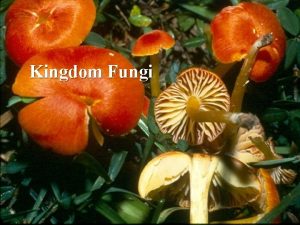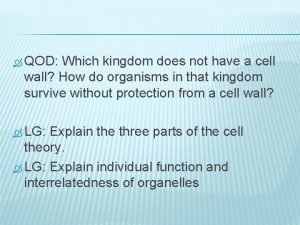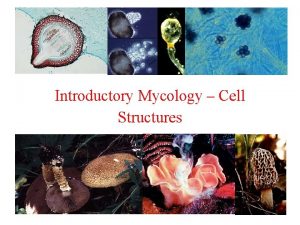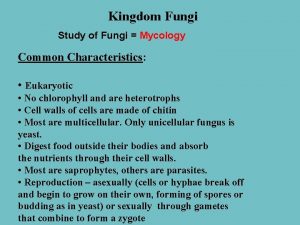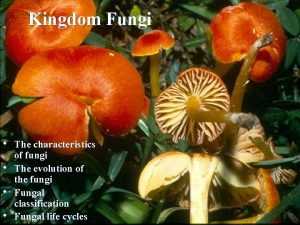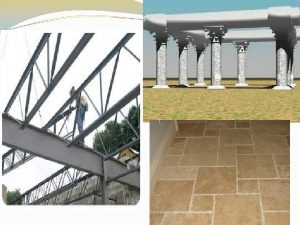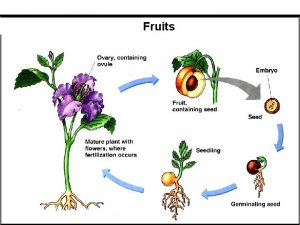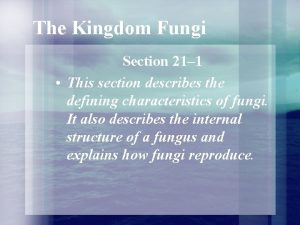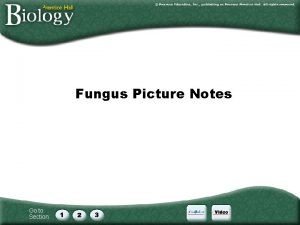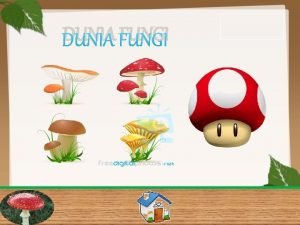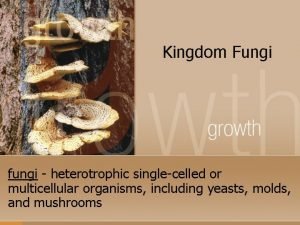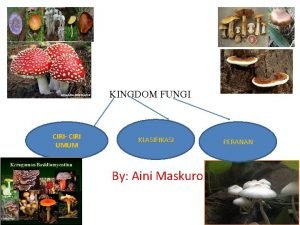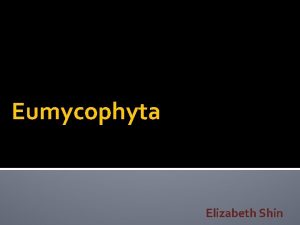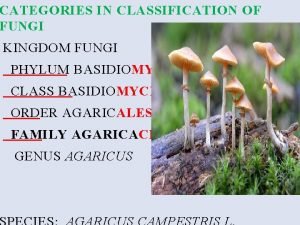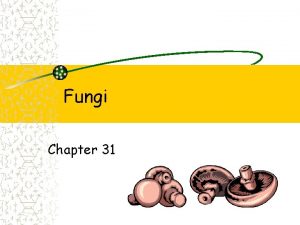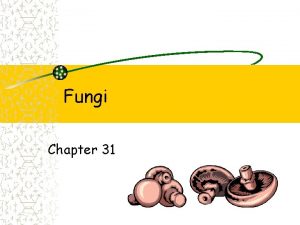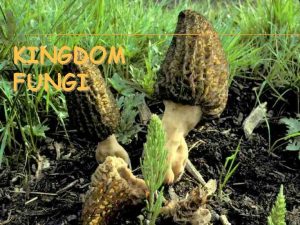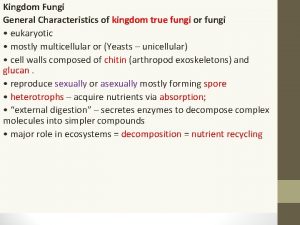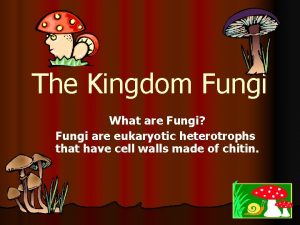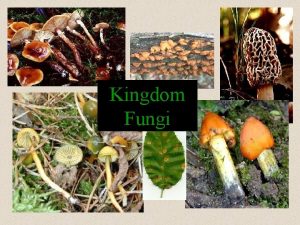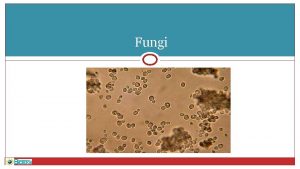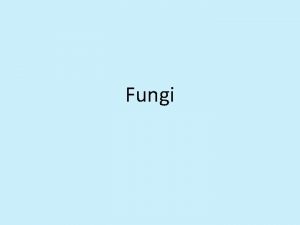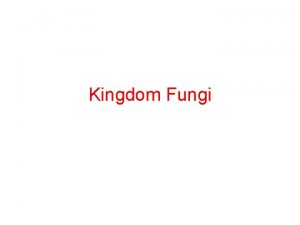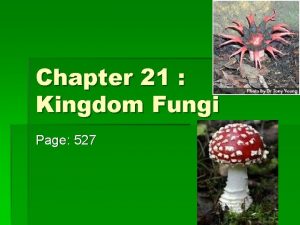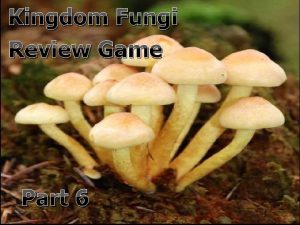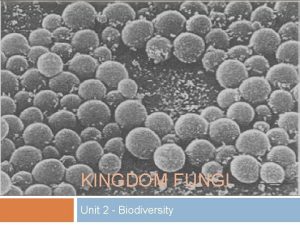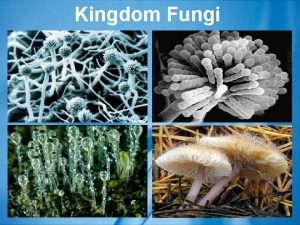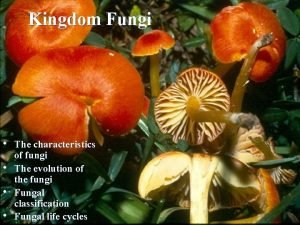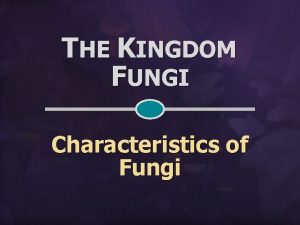Kingdom Fungi The Characteristics of Fungi Cell wall
































- Slides: 32

Kingdom Fungi

The Characteristics of Fungi • • • Cell wall * cellulose and/or chitin. Eukaryotes * nucleus and other organelles require water and oxygen (no obligate anaerobes) grow in almost every habitat imaginable Diverse * estimated 1. 5 million species total

The Characteristics of Fungi • unicellular or multicellular • Filamentous * tube-like strands called hypha (singular) or hyphae (plural) * mycelium = aggregate of hyphae

fruiting bodies both are composed of hyphae mycelium

Hyphae • • • Tubular Hard wall of chitin Crosswalls may form compartments Multinucleate Grow at tips

Modifications of hyphae

Mycorrhizae • • “Fungus roots” Mutualism between: * Fungus (nutrient & water uptake for plant) * Plant (carbohydrate for fungus) • Several kinds * Zygomycota – hyphae invade root cells * Ascomycota & Basidiomycota – hyphae invade root but don’t penetrate cells • Extremely important ecological role of fungi!

Heterotrophic by Absorption • • Fungi get carbon from organic sources Hyphal tips release enzymes Enzymatic breakdown of substrate Products diffuse back into hyphae Nucleus hangs back and “directs” Product diffuses back into hypha and is used

• Saprophytes or saprobes - feed on dead • • tissues or organic waste (decomposers) Symbionts - mutually beneficial relationship between a fungus and another organism Parasites - feeding on living tissue of a host. • Parasites that cause disease are called pathogens.

Fungi as Saprobes and Decomposers

Fungi as Symbionts (Mutualism)

“Ecto”mycorrhizae Russula mushroom mycorrhizas on Western Hemlock root Fungal hyphae around root and between cells Mycorrhiza cross sections

Lichens • “Mutualism” between • * Fungus – structure * Alga or cyanobacterium – provides food Three main types of lichens: * Crustose lichens form flat crusty plates. * Foliose lichens are leafy in appearance * Fruticose lichens are even more finely branched and may hang down like beards from branches or grow up from the ground like tiny shrubs.

Lichen internal structure Lichens are nature’s biological monitors of pollution and air quality • Thalli act like sponges • Some species more sensitive to pollution • Which species are present can indicate air quality • Most resistant species can also be analyzed for pollutants, including bioaccumulation of heavy metals and radioactive isotopes Lobaria

Fungi as Parasites & Pathogens

Fungi are Spore-ific!!! • • Spores - asexual (product of mitosis) or sexual (product of meiosis) in origin. Purpose of Spores * Allows the fungus to move * allows fungus to survive drought * Introduce new genetic combinations

• • Reproduce by spores Spores are reproductive cells * Sexual (meiotic in origin) * Asexual (mitotic in origin) Formed: * Directly on hyphae * Inside sporangia * Fruiting bodies Penicillium hyphae with conidia Pilobolus sporangia Amanita fruiting body

Hyphal growth from spore germinating spore mycelium • Mycelia have a huge surface area

asci zygosporangia motile spores basidia Classification & Phylogeny

• • Chytridiomycota – “chytrids” Simple fungi Produce motile spores zoospores Mostly saprobes and parasites in aquatic habitats Could just as well be Protists Chytridium growing on spores Chytriomyces growing on pine pollen

Zygomycota – “zygote fungi” Rhizopus on strawberries • • • Sexual Reproduction zygosporangia Asexual reprod. – common (sporangia – bags of asexual spores) Hyphae have no cross walls Grow rapidly Decomposers, pathogens, and some form mycorrhizal associations with plants

Ascomycota – “sac fungi” • • • Sexual Reproduction – asci (sing. = ascus) Asex. Reprod. – common Cup fungi, morels, truffles Important plant parasites & saprobes Yeast - Saccharomyces Decomposers, pathogens, and found in most lichens A cluster of asci with spores inside

Sac fungi diversity

Basidiomycota – “club fungi” • • Sexual Reproduction – basidia Asexual reprod – not so common Long-lived dikaryotic mycelia Rusts & smuts –plant parasites Mushrooms, polypores, puffballs, boletes, bird’s nest fungi Enzymes decompose wood, leaves, and other organic materials Decomposers, pathogens, and some form mycorrhizal associations with plants SEM of basidia and spores

Hyphal fusion mycelium and fruiting of haploid body are dikaryotic mycelia haploid mycelium Mushroom Life Cycle N Meiosis 2 N N+N Nuclear fusion in basidium young basidia - the only diploid cells

Bioluminescence in Mycena

Yeasts • • Single celled fungi Adapted to liquids * Plant saps * Water films * Moist animal tissues Saccharomyces Candida

Molds • • • Rapidly growth Asexual spores Many human importances * Food spoilage * Food products * Antibiotics, etc. Noble Rot - Botrytis Fig 31. 21 Antibiotic activity

HUMAN-FUNGUS INTERACTIONS • • Beneficial Effects of Fungi * Decomposition - nutrient and carbon recycling. * Biosynthetic factories. Can be used to produce drugs, antibiotics, alcohol, acids, food (e. g. , fermented products, mushrooms). * Model organisms for biochemical and genetic studies. Harmful Effects of Fungi * Destruction of food, lumber, paper, and cloth. * Animal and human diseases, including allergies. * Toxins produced by poisonous mushrooms and within food (e. g. , grain, cheese, etc. ). * Plant diseases.

Fungal Funnies


 Fungal cell walls are characteristic in having
Fungal cell walls are characteristic in having Old kingdom middle kingdom new kingdom
Old kingdom middle kingdom new kingdom Nnn ruled
Nnn ruled Old kingdom middle kingdom new kingdom
Old kingdom middle kingdom new kingdom Mentohotep
Mentohotep Protista mobility
Protista mobility Plantae kingdom drawing
Plantae kingdom drawing Domain eukarya kingdom plantae
Domain eukarya kingdom plantae What kingdom does not have a cell wall
What kingdom does not have a cell wall Fungi eukaryotic
Fungi eukaryotic Function of the cell wall
Function of the cell wall Cell wall cell membrane
Cell wall cell membrane Characteristics of kingdom fungi
Characteristics of kingdom fungi Phylum chytridiomycota reproductive structure
Phylum chytridiomycota reproductive structure Plazmogamie
Plazmogamie Characteristics of eukarya
Characteristics of eukarya Sound wall vs word wall
Sound wall vs word wall Chris brown wall
Chris brown wall English bond t junction elevation
English bond t junction elevation Members used to carry wall loads over wall openings
Members used to carry wall loads over wall openings Pod fruit develops from
Pod fruit develops from Trichomoniasis
Trichomoniasis Section 21-1 the kingdom fungi
Section 21-1 the kingdom fungi Concept map of kingdom fungi
Concept map of kingdom fungi Buatlah peta konsep fungi
Buatlah peta konsep fungi Kingdom monera protista fungi plantae animalia
Kingdom monera protista fungi plantae animalia Kingdom fungi domain
Kingdom fungi domain Basidiom
Basidiom Are fungi single or multicellular
Are fungi single or multicellular Is kingdom fungi unicellular or multicellular
Is kingdom fungi unicellular or multicellular Fragmentasi miselium
Fragmentasi miselium Phycomycetes
Phycomycetes Taxonomic classification of fungi
Taxonomic classification of fungi
